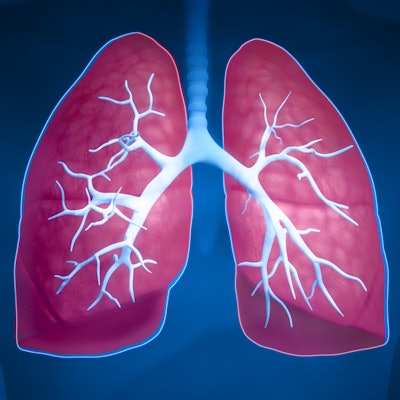
In an update to the National Lung Screening Trial (NLST), researchers from the U.S. are reporting a sustained reduction in cancer deaths from CT lung screening roughly 12 years after the initial screening exam. The findings were recently published online in the Journal of Thoracic Oncology.
The original NLST demonstrated that the number of high-risk smokers who died from lung cancer within the first 6.5 years after CT lung screening was at least 20% lower than those who underwent x-ray lung screening.
In the new study, researchers led by Paul Pinsky, PhD, of the U.S. National Cancer Institute performed a secondary analysis of the NLST by tracking lung cancer incidence in NLST participants for a median of 11.3 years and lung cancer mortality for a median of 12.3 years from the time of baseline screening. Their aim was to determine whether the statistically significant reduction in lung cancer mortality from the first NLST report would carry through this extended period of time (J Thorac Oncol, June 28, 2019).
Among roughly 53,000 study participants, the incidence of lung cancer was nearly the same for individuals in both the x-ray and CT lung screening cohorts. However, the lung cancer mortality rate per 1,000 individuals was 3.3 points lower for the CT screening group than it was for the x-ray group. This reduction in lung cancer mortality rate was comparable to the reduction of 3.1 points observed in the original study.
In other terms, the risk ratio of lung cancer mortality in the CT screening group compared with the x-ray group was 0.89 (p = 0.043), after adjusting to consider only the deaths of individuals who were diagnosed with cancer during the actual screening period.
| X-ray vs. CT lung cancer screening in an extended analysis of the NLST | ||
| X-ray | CT | |
| Lung cancer incidence, no. of cases | 1,681 | 1,701 |
| Lung cancer mortality rate per 1,000 individuals | 46.2 | 42.9 |
| Lung cancer mortality rate per 1,000 individuals (after adjustment)* | 24.2 | 21.6 |
| All-cause mortality rate per 1,000 individuals | 200.7 | 196.6 |
| Proportion of stage I lung cancers* | 27.5% | 39.6% |
The reduction in all-cause mortality rate for the CT group compared with the x-ray group was also essentially sustained in the extended study, although the difference no longer reached a point of statistical significance.
Furthermore, the researchers calculated that the number of individuals who needed to undergo screening to prevent one death from lung cancer was 303, which was comparable to the 320 reported in the original NLST. They also found that the rate of overdiagnosis fell to 3.1%, a considerable drop from an estimated 18% in the original study.
The extended follow-up study of the NLST shows that CT lung screening did prevent, or at least delay, lung cancer deaths for more than a decade -- reaffirming the results of extended, large-scale studies in Europe such as the Dutch-Belgian Randomized Lung Cancer Screening (NELSON) trial, Pinsky noted in a statement from the International Association for the Study of Lung Cancer.
"Lung cancer is the leading cause of cancer death worldwide, and early detection and treatment through screening with low-dose computed tomography has been investigated as a potential means of reducing lung cancer deaths for more than two decades," he said. "This study adds further weight to the notion that CT screening is effective."



















